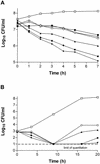Effect of the echinocandin caspofungin on expression of Candida albicans secretory aspartyl proteinases and phospholipase in vitro
- PMID: 12183282
- PMCID: PMC127410
- DOI: 10.1128/AAC.46.9.3096-3100.2002
Effect of the echinocandin caspofungin on expression of Candida albicans secretory aspartyl proteinases and phospholipase in vitro
Abstract
Although the echinocandin caspofungin primarily inhibits the synthesis of cell wall 1,3-beta-D-glucan, its fungicidal activity could also potentially perturb the expression of virulence factors involved in the ability of Candida albicans to cause infection. Expression of the C. albicans secretory aspartyl proteinase (SAP) and phospholipase B (PLB) virulence genes was determined by reverse transcription-PCR after the addition of caspofungin to cells grown for 15 h in Sabouraud dextrose broth. In cells that remained viable, expression of SAP1 to SAP3, SAP7 to SAP9, and PLB1 was unaltered after exposure to fungicidal concentrations (4 to 16 micro g/ml) of caspofungin over a period of 7 h. However, expression of SAP5 increased steadily beginning 1 h after exposure to caspofungin. These results indicate that caspofungin is rapidly fungicidal against C. albicans, before any suppression of SAP or PLB1 gene expression can occur.
Figures


Similar articles
-
Exposure of Candida albicans to antifungal agents affects expression of SAP2 and SAP9 secreted proteinase genes.J Antimicrob Chemother. 2005 May;55(5):645-54. doi: 10.1093/jac/dki088. Epub 2005 Apr 8. J Antimicrob Chemother. 2005. PMID: 15820985
-
In vivo analysis of secreted aspartyl proteinase expression in human oral candidiasis.Infect Immun. 1999 May;67(5):2482-90. doi: 10.1128/IAI.67.5.2482-2490.1999. Infect Immun. 1999. PMID: 10225911 Free PMC article.
-
In vitro activity of caspofungin (MK-0991) against Candida albicans clinical isolates displaying different mechanisms of azole resistance.J Clin Microbiol. 2002 Jun;40(6):2228-30. doi: 10.1128/JCM.40.6.2228-2230.2002. J Clin Microbiol. 2002. PMID: 12037093 Free PMC article.
-
The echinocandins.Pharmacotherapy. 2007 Mar;27(3):369-88. doi: 10.1592/phco.27.3.369. Pharmacotherapy. 2007. PMID: 17316149 Review.
-
Caspofungin acetate: an antifungal agent.Am J Health Syst Pharm. 2001 Jul 1;58(13):1206-14; quiz 1215-7. doi: 10.1093/ajhp/58.13.1206. Am J Health Syst Pharm. 2001. PMID: 11449878 Review.
Cited by
-
Broad-Spectrum Activity and Mechanisms of Action of SQ109 on a Variety of Fungi.ACS Infect Dis. 2025 Jun 13;11(6):1662-1672. doi: 10.1021/acsinfecdis.5c00210. Epub 2025 May 14. ACS Infect Dis. 2025. PMID: 40367247 Free PMC article.
-
Broad-Spectrum Activity and Mechanisms of Action of SQ109 on a Variety of Fungi.bioRxiv [Preprint]. 2025 Feb 3:2025.02.03.636131. doi: 10.1101/2025.02.03.636131. bioRxiv. 2025. Update in: ACS Infect Dis. 2025 Jun 13;11(6):1662-1672. doi: 10.1021/acsinfecdis.5c00210. PMID: 39975329 Free PMC article. Updated. Preprint.
-
Pneumocystis jirovecii dihydropteroate synthase gene mutations in a group of HIV-negative immunocompromised patients with Pneumocystis pneumonia.Exp Ther Med. 2014 Dec;8(6):1825-1830. doi: 10.3892/etm.2014.2002. Epub 2014 Oct 3. Exp Ther Med. 2014. PMID: 25371739 Free PMC article.
-
Plant-Derived Substances in the Fight Against Infections Caused by Candida Species.Int J Mol Sci. 2020 Aug 25;21(17):6131. doi: 10.3390/ijms21176131. Int J Mol Sci. 2020. PMID: 32854425 Free PMC article. Review.
-
Effect of azoles on the secretion of a Candida albicans metallopeptidase.Mycopathologia. 2006 Mar;161(3):147-52. doi: 10.1007/s11046-005-3085-4. Mycopathologia. 2006. PMID: 16482386
References
-
- Abruzzo, G. K., A. M. Flattery, C. J. Gill, L. Kong, J. G. Smith, V. B. Pikounis, J. M. Balkovec, A. F. Bouffard, J. F. Dropinski, H. Rosen, H. Kropp, and K. Bartizal. 1997. Evaluation of the echinocandin antifungal MK-0991 (L-743,872): efficacies in mouse models of disseminated aspergillosis, candidiasis, and cryptococcosis. Antimicrob. Agents Chemother. 41:2333-2338. - PMC - PubMed
-
- Abruzzo, G. K., C. J. Gill, A. M. Flattery, L. Kong, C. Leighton, J. G. Smith, V. P. Pikounis, K. Bartizal, and H. Rosen. 2000. Efficacy of the echinocandin caspofungin against disseminated aspergillosis and candidiasis in cyclophosphamide-induced immunosuppressed mice. Antimicrob. Agents Chemother. 44:2310-2318. - PMC - PubMed
-
- Angiolella, L., M. Facchin, A. Stringaro, B. Maras, N. Simonetti, and A. Cassone. 1996. Identification of a glucan-associated enolase as a main cell wall protein of Candida albicans and an indirect target of lipopeptide antimycotics. J. Infect. Dis. 173:684-690. - PubMed
-
- Balani, S. K., X. Xu, B. H. Arison, M. V. Silva, A. Gries, F. A. DeLuna, D. Cui, P. H. Kari, T. Ly, C. E. Hop, R. Singh, M. A. Wallace, D. C. Dean, J. H. Lin, P. G. Pearson, and T. A. Baillie. 2000. Metabolites of caspofungin acetate, a potent antifungal agent, in human plasma and urine. Drug Metab. Dispos. 28:1274-1278. - PubMed
-
- Balkovec, J. M., R. M. Black, G. K. Abruzzo, K. Bartizal, S. Dreikorn, and K. Nollstadt. 1993. Pneumocandin antifungal lipopeptides. The phenolic hydroxyl is required for 1,3-β-d-glucan synthesis inhibition. Bioorg. Med. Chem. Lett. 3:2039-2042.
Publication types
MeSH terms
Substances
LinkOut - more resources
Full Text Sources
Medical
Miscellaneous

